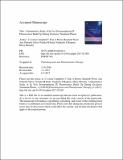Files in this item
A quantitative study of in vivo protoporphyrin IX fluorescence build up during occlusive treatment phases
Item metadata
| dc.contributor.author | Campbell, C. Louise | |
| dc.contributor.author | Brown, C. Tom A. | |
| dc.contributor.author | Wood, Kenneth | |
| dc.contributor.author | Salvio, Ana Gabriela | |
| dc.contributor.author | Inada, Natalia M. | |
| dc.contributor.author | Bagnato, Vanderlei S. | |
| dc.contributor.author | Moseley, Harry | |
| dc.date.accessioned | 2018-03-01T00:33:05Z | |
| dc.date.available | 2018-03-01T00:33:05Z | |
| dc.date.issued | 2017-06 | |
| dc.identifier | 249267506 | |
| dc.identifier | 2f39d826-1b6c-4968-b65b-701393e54e81 | |
| dc.identifier | 85015425048 | |
| dc.identifier | 000404315000031 | |
| dc.identifier.citation | Campbell , C L , Brown , C T A , Wood , K , Salvio , A G , Inada , N M , Bagnato , V S & Moseley , H 2017 , ' A quantitative study of in vivo protoporphyrin IX fluorescence build up during occlusive treatment phases ' , Photodiagnosis and Photodynamic Therapy , vol. 18 , pp. 204-207 . https://doi.org/10.1016/j.pdpdt.2017.02.004 | en |
| dc.identifier.issn | 1572-1000 | |
| dc.identifier.other | RIS: urn:336ECA73D79EB54F1A3D1CAB4448AE42 | |
| dc.identifier.other | ORCID: /0000-0002-4405-6677/work/86537160 | |
| dc.identifier.uri | https://hdl.handle.net/10023/12823 | |
| dc.description | C L Campbell acknowledges financial support from an UK EPSRC PhD studentship (EP/K503162/1), the Alfred Stewart Trust, the Russell trust award, the Santander mobility award and the FAPESP CEPOF grant 2013/07276. | en |
| dc.description.abstract | Background: Topical photodynamic therapy (PDT) is a non-invasive light based therapy used to treat non-melanoma skin cancer (NMSC) and dysplasia. During PDT, the light sensitive molecule protoporphyrin IX (PpIX) is activated, resulting in the production of singlet oxygen, which subsequently leads to cell death. PpIX is metabolised from a topically applied pro-drug and the strong fluorescence signal associated with PpIX can be utilised as an indicator of the amount of PpIX present within the tumour tissue. In this work we measure the build up PpIX during the occlusive treatment phase and investigate how the PpIX production rate is affected by different lesion and patient characteristics. Methods : Fluorescence measurements were used to investigate the build up of PpIX within the tumour tissue during the 3 hour long occlusive treatment prior to irradiation. The study included in vivo measurements of 38 lesions from 38 individual patients. Actinic keratosis (AK) and basal cell carcinoma (BCC) were the lesion types included in this study. The resulting data from the study was analysed using generalised linear mixed effects models. Results : It was found that the surface fluorescence signal linearly increased with occlusive treatment time. The predictive models suggest that there is a significant difference in PpIX production between lesion location, however no significant difference is demonstrated between different lesion types, gender and skin type. Conclusions : The study extends and supports previous knowledge of PpIX production during the occlusive treatment phase. | |
| dc.format.extent | 354774 | |
| dc.language.iso | eng | |
| dc.relation.ispartof | Photodiagnosis and Photodynamic Therapy | en |
| dc.subject | QC Physics | en |
| dc.subject | RC0254 Neoplasms. Tumors. Oncology (including Cancer) | en |
| dc.subject | RL Dermatology | en |
| dc.subject | NDAS | en |
| dc.subject | SDG 3 - Good Health and Well-being | en |
| dc.subject.lcc | QC | en |
| dc.subject.lcc | RC0254 | en |
| dc.subject.lcc | RL | en |
| dc.title | A quantitative study of in vivo protoporphyrin IX fluorescence build up during occlusive treatment phases | en |
| dc.type | Journal article | en |
| dc.contributor.institution | University of St Andrews. School of Physics and Astronomy | en |
| dc.identifier.doi | 10.1016/j.pdpdt.2017.02.004 | |
| dc.description.status | Peer reviewed | en |
| dc.date.embargoedUntil | 2018-02-28 |
This item appears in the following Collection(s)
Items in the St Andrews Research Repository are protected by copyright, with all rights reserved, unless otherwise indicated.

